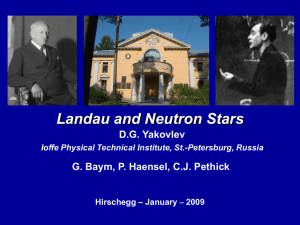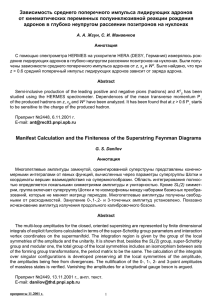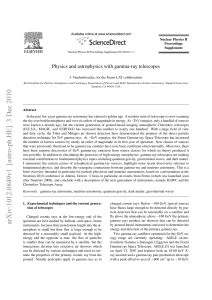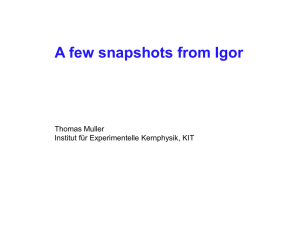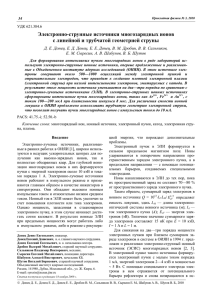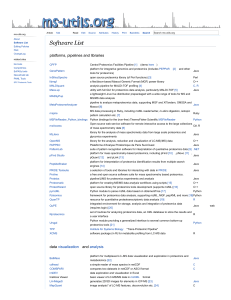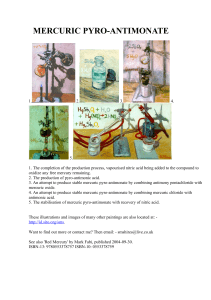IRuskov-Themes for Students Practice 2016 JINR-FLNP-proposal-v2
advertisement
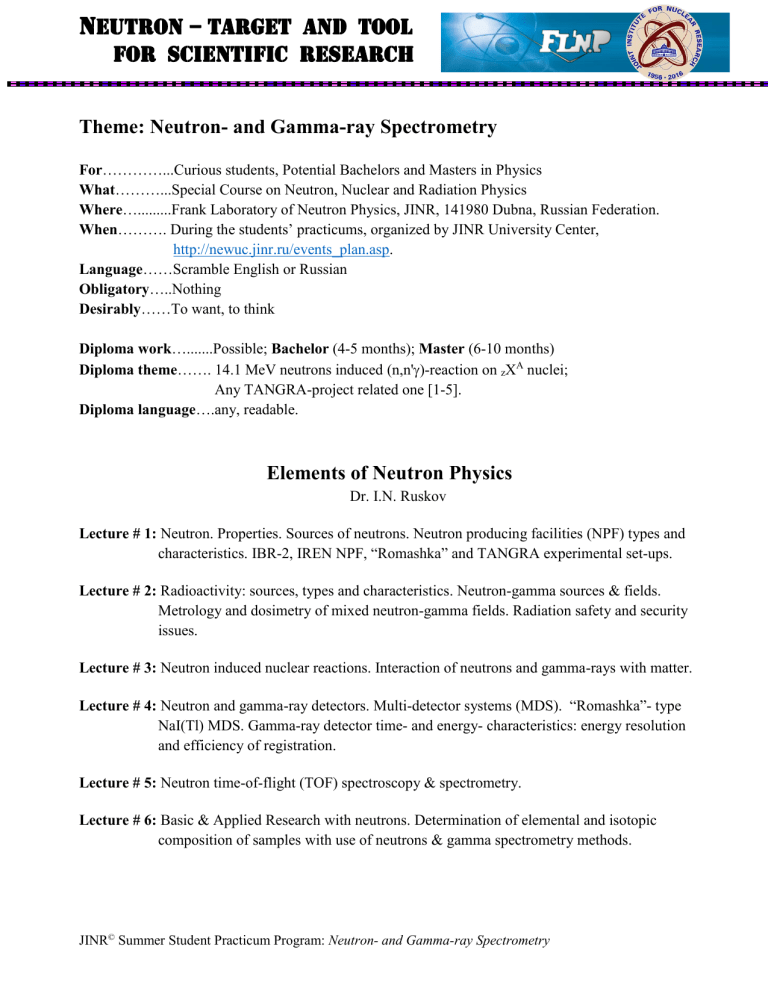
Neutron – Target and Tool For Scientific Research Theme: Neutron- and Gamma-ray Spectrometry For…………...Curious students, Potential Bachelors and Masters in Physics What………...Special Course on Neutron, Nuclear and Radiation Physics Where….........Frank Laboratory of Neutron Physics, JINR, 141980 Dubna, Russian Federation. When………. During the students’ practicums, organized by JINR University Center, http://newuc.jinr.ru/events_plan.asp. Language……Scramble English or Russian Obligatory…..Nothing Desirably……To want, to think Diploma work….......Possible; Bachelor (4-5 months); Master (6-10 months) Diploma theme……. 14.1 MeV neutrons induced (n,n')-reaction on zXA nuclei; Any TANGRA-project related one [1-5]. Diploma language….any, readable. Elements of Neutron Physics Dr. I.N. Ruskov Lecture # 1: Neutron. Properties. Sources of neutrons. Neutron producing facilities (NPF) types and characteristics. IBR-2, IREN NPF, “Romashka” and TANGRA experimental set-ups. Lecture # 2: Radioactivity: sources, types and characteristics. Neutron-gamma sources & fields. Metrology and dosimetry of mixed neutron-gamma fields. Radiation safety and security issues. Lecture # 3: Neutron induced nuclear reactions. Interaction of neutrons and gamma-rays with matter. Lecture # 4: Neutron and gamma-ray detectors. Multi-detector systems (MDS). “Romashka”- type NaI(Tl) MDS. Gamma-ray detector time- and energy- characteristics: energy resolution and efficiency of registration. Lecture # 5: Neutron time-of-flight (TOF) spectroscopy & spectrometry. Lecture # 6: Basic & Applied Research with neutrons. Determination of elemental and isotopic composition of samples with use of neutrons & gamma spectrometry methods. JINR© Summer Student Practicum Program: Neutron- and Gamma-ray Spectrometry Neutron – Target and Tool For Scientific Research Elements of Programming and Physical Simulations Dr. Yu.N. Kopatch Lecture # 1: LINUX operation system Lecture # 2: Programing language C++, software for data analysis (ROOT) and modeling (GEANT4) Lecture # 3: Software for digital signal processing (ADCM) and analysis (ROMANA, TOFANA) Objectives The techniques of C++ programing, CERN ROOT script creating, GEANT4 physics experiments simulations in PC Linux Mint operation system, are explored. You will become familiar with: - PC Linux Mint operation system; - Data acquisition and visualization software ADCM; - Data reduction and analysis by ROMANA and TOFANA; - Basic knowledge of physics experiment simulations by GEANT4. JINR© Summer Student Practicum Program: Neutron- and Gamma-ray Spectrometry Neutron – Target and Tool For Scientific Research Laboratory Practicum # 1 Study of TANGRA experimental setup for basic and applied nuclear research with 14.1 MeV neutrons [2] Objectives Techniques in development of a computerize system for investigation of 14.1 MeV neutrons induced nuclear reactions explored. You will learn: - about tagging of 14.1MeV neutrons by the associated with them alpha-particles; - to use a computerized system for experimental data acquisition and analysis; - to identify and explain the photo-peak, the Compton edge, and the backscatter, single and doubleescape peaks, associated with gamma-ray interactions; - to calibrate the detector (system) with standard point sources of gamma-rays; - to determine the activity and half-life of gamma ray irradiating isotopes. The outcome from the practice will be a report on description of the tools and methods which are going to be used for the investigation of 14.1 MeV neutrons inducing nuclear reactions. JINR© Summer Student Practicum Program: Neutron- and Gamma-ray Spectrometry Neutron – Target and Tool For Scientific Research Laboratory Practicum # 2 Optimization of Multilayer Passive Shielding of NaI(Tl) Scintillation Crystal Probes Operating in Intense Neutron Fields with Energy of 14.1 MeV [4] Objectives Techniques in gamma ray spectroscopy & spectrometry using a hexagonal NaI(Tl) scintillation detector are explored. You will learn: - to use a computerized system for experimental data acquisition and analysis; - to identify and explain the photo-peak, the Compton edge, and the backscatter, single and doubleescape peaks, associated with gamma-ray interactions; - to determine the suppression factor of different materials to be used as a shielding. The outcome from the practice will be a report on the optimization of multi-layer shielding-collimator for protecting the “Romashka” multi-detector scintillation array from the direct and scattered 14.1 MeV neutrons from the neutron generator ING-27. JINR© Summer Student Practicum Program: Neutron- and Gamma-ray Spectrometry Neutron – Target and Tool For Scientific Research Laboratory Practicum # 3 Determination of the anisotropy of irradiation of gamma-rays in the inelastic scattering of 14.1MeV neutrons on carbon [4] Objectives Techniques in gamma ray spectroscopy & spectrometry using a hexagonal NaI(Tl) scintillation detector are explored. You will learn: - to use a computerized system for experimental data acquisition (ADCM) and analysis (ROMANA); - to identify and explain the photo-peak, the Compton edge, and the backscatter, single and doubleescape peaks, associated with interaction of 4.44 MeV with the NaI(Tl) crystal media; - to determine the full-energy peak area by fitting a suitable function(s) to the gamma-ray energy spectrum; - to calculate the angular anisotropy of irradiation of 4.44 MeV gamma-rays. The outcome from the practice will be a report on the results obtained. JINR© Summer Student Practicum Program: Neutron- and Gamma-ray Spectrometry Neutron – Target and Tool For Scientific Research Laboratory Practicum # 4 Gamma-ray energy calibration of the “Romashka” array Objectives Techniques in gamma ray spectroscopy & spectrometry using a hexagonal NaI(Tl) scintillation detector are explored. You will learn: - to use a computerized system for experimental data acquisition and analysis; - to identify and explain the photo-peak, the Compton edge, and the backscatter, single and doubleescape peaks, associated with gamma-ray interactions; - to calibrate the detector (system) with standard point sources of gamma-rays; - to determine the activity and half-life of gamma ray irradiating isotopes. The outcome from the practice will be a report on the results obtained. JINR© Summer Student Practicum Program: Neutron- and Gamma-ray Spectrometry Neutron – Target and Tool For Scientific Research Laboratory Practicum # 5 Investigation of natural background gamma-radiation by “Romashka” array [3, 6-8] Objectives Techniques in gamma-ray spectroscopy & spectrometry using NaI(Tl) scintillation gamma-detector array, ADCM and ROMANA are explored. You will learn: - to work in Linux environment; - to become familiar with the program for NaI(Tl) pulse processing (ADCM), visualization and analysis (ROMANA); - to determine the main components of the gamma-radiation background in the laboratory; The outcome from the practice will be a report on the results obtained. JINR© Summer Student Practicum Program: Neutron- and Gamma-ray Spectrometry Neutron – Target and Tool For Scientific Research Laboratory Practicum # 6 Gamma Ray Spectroscopy by PC Sound card [9] Objectives Techniques in gamma ray spectroscopy & spectrometry using a hexagonal NaI(Tl) scintillation detector and a USB Sound card as a multichannel pulse analyzer are explored. You will learn: - to investigate the performance a different (PC, USB) sound cards for experimental data acquisition; - to compare different sound card freeware software for data acquisition and visualization; - to identify and explain the photo-peak, the Compton edge, backscatter, single and double-escape peaks, associated with gamma-ray interactions; - to compare the PC USB sound card performance with PCI and main board ones using a hexagonal NaI(Tl) probe and (137Cs and 60Co) standard point gamma-ray sources. Relevant parameters for NaI(Tl) are: ** Density: 3.67 g/cm3; ** Z: Na=11, I=53, Tl=81; ** Decay time: 230 ns @ 25 °C. ** Luminescent efficiency: 12% of energy of incident radiation. ** Temperature coefficient of luminescence: 0.2 to 2% per οC. ** Wavelength of maximum emission: 420 nm. ** Index of refraction: 1.85 @ 420 nm. ** Energy resolution: 6.5% @ 662 KeV at best. (7.5% typical) JINR© Summer Student Practicum Program: Neutron- and Gamma-ray Spectrometry Neutron – Target and Tool For Scientific Research References 1. Yu.N. Kopatch (for TANGRA collaboration), Development of the tagged neutron method for elemental analysis and nuclear reaction studies – TANGRA project, http://isinn.jinr.ru/past-isinns/isinn-22/progr28_05_2014/Kopatch.pdf. 2. I.N. Ruskov, Yu.N. Kopatch, V.M. Bystritsky et al., TANGRA-Setup for the Investigation of Nuclear Fission induced by 14.1 MeV neutrons, Physics Procedia 64 (2015) 163-170; ISSN 23:1875-3892, Elsevier, http://www.sciencedirect.com/science/article/pii/S1875389215001388. 3. D.N. Grozdanov, A.O. Zontikov, Optimization of "Romashka" setup for investigation of (n, n'gamma)-reactions with tagged neutrons method, ISINN-23 proceedings: http://isinn.jinr.ru/pastisinns/isinn-23/program.html.. 4. V.M. Bystritsky, V. Valkovic, D.N. Grozdanov et al., Multilayer Passive Shielding of Scintillation Detectors Based on BGO, NaI(Tl) and Stilbene Crystals Operating in Intense Neutron Fields with an Energy of 14.1 MeV, Physics of Particles and Nuclei Letters 12(2) (2015) 325-335. 5. Yu.N. Kopatch, D.N. Grozdanov, A.O. Zontikov et al., Angular correlation of gamma-rays in the inelastic scattering of 14 MeV neutrons on carbon, ISINN-23, May 26-29, 2015, Dubna, http://isinn.jinr.ru/past-isinns/isinn-23/progr-29_05_2015/Kopatch.pdf.. 6. G.F. Knoll, Radiation Detection and Measurement – 3rd edition, John Wiley & Sons, New York, 2000, http://physics.ut.ac.ir/~shafiei/pub/knoll.pdf. 7. W.R. Leo, Techniques for Nuclear and Particle Physics Experiments: A How-to Approach, 2nd. rev. ed., Springer-Verlag, 1994. 8. A.C. Melissinos and J. Napolitano, Experiments in Modern Physics, Academic Press, 2003, ch.9.2. 9. I.N. Ruskov, Universal Monitor of Low Intensity Mixed Neutron-Gamma Radiation Fields Utilizing the Computer Sound Card as Multichannel Pulse Analyzer, http://isinn.jinr.ru/proceedings/isinn22/pdf/ruskov.pdf. Contacts: Director: Program Curator: Local Contacts: Supervisors: Assistants: Address: JINR, University Center, Joliot Curie 6, Dubna, Moscow region, 141980 Russia Name, Surname Degree Position Telephone: Stanislav Z. Pakuliak Sc.D Professor +7 (496216) Elena G. Karpova 5089, 4080, 4942 Frank Laboratory of Neutron Physics, Department of Nuclear Physics Yuri N. Kopatch Ph.D Section head +7 (496216) 2459 Ivan N. Ruskov Ph.D Senior scientist +7 (496216) 2785 Dimitar N. Grozdanov Junior scientist +7 (496216) 3131 Fuad A. Aliyev Engineer +7 (496216) 3131 Fax: +7 (49621) 65851 e-mail students@jinr.ru kopatch@nf.jinr.ru ruskoiv@nf.jinr.ru dimitar@flnp.jinr.ru fuad.aliyev107@gmail.com Composed by: Dr. I.N. Ruskov Tel. +7 (496216) 2785; e-mail: ruskoiv@nf.jinr.ru JINR© Summer Student Practicum Program: Neutron- and Gamma-ray Spectrometry
